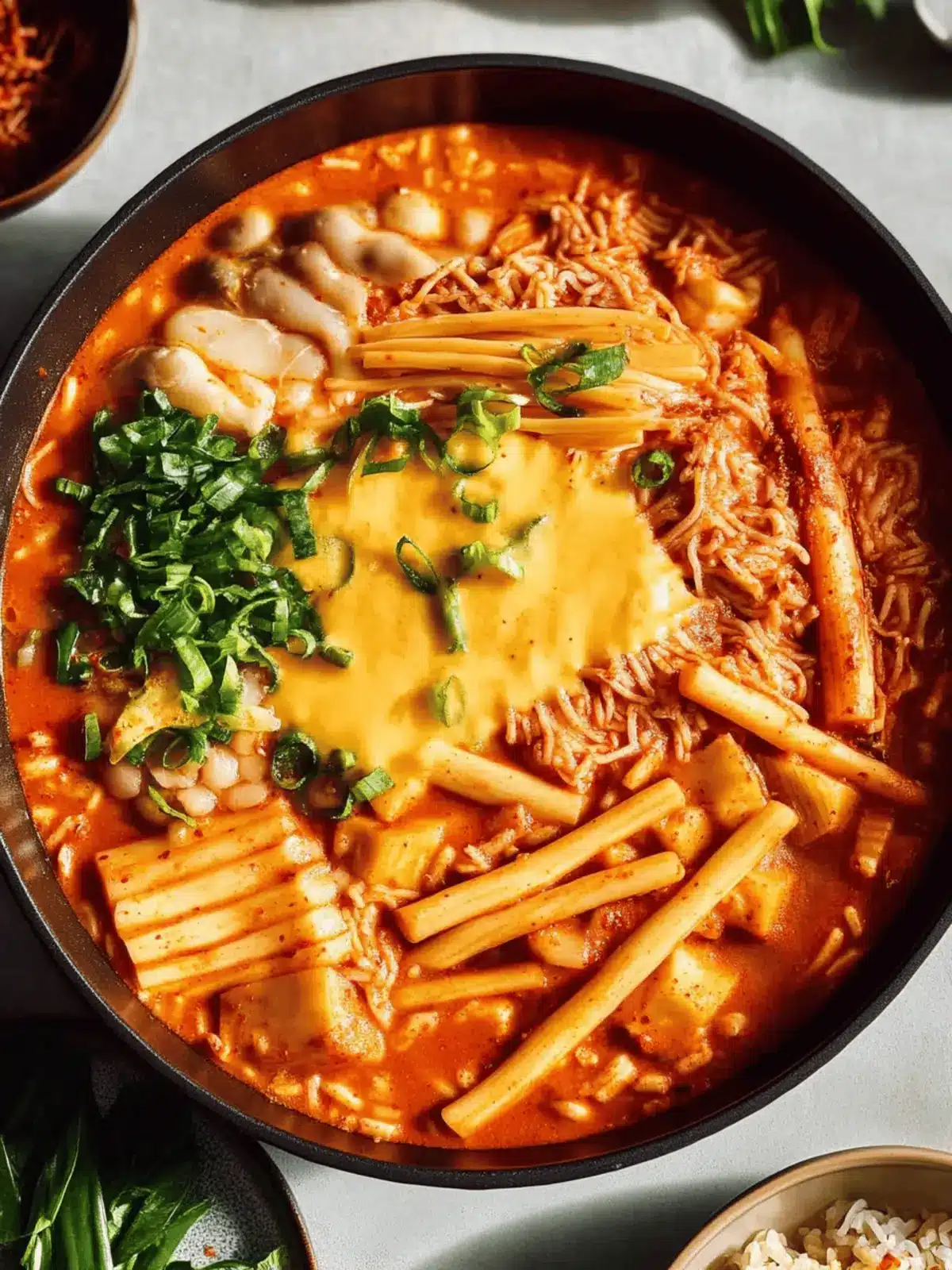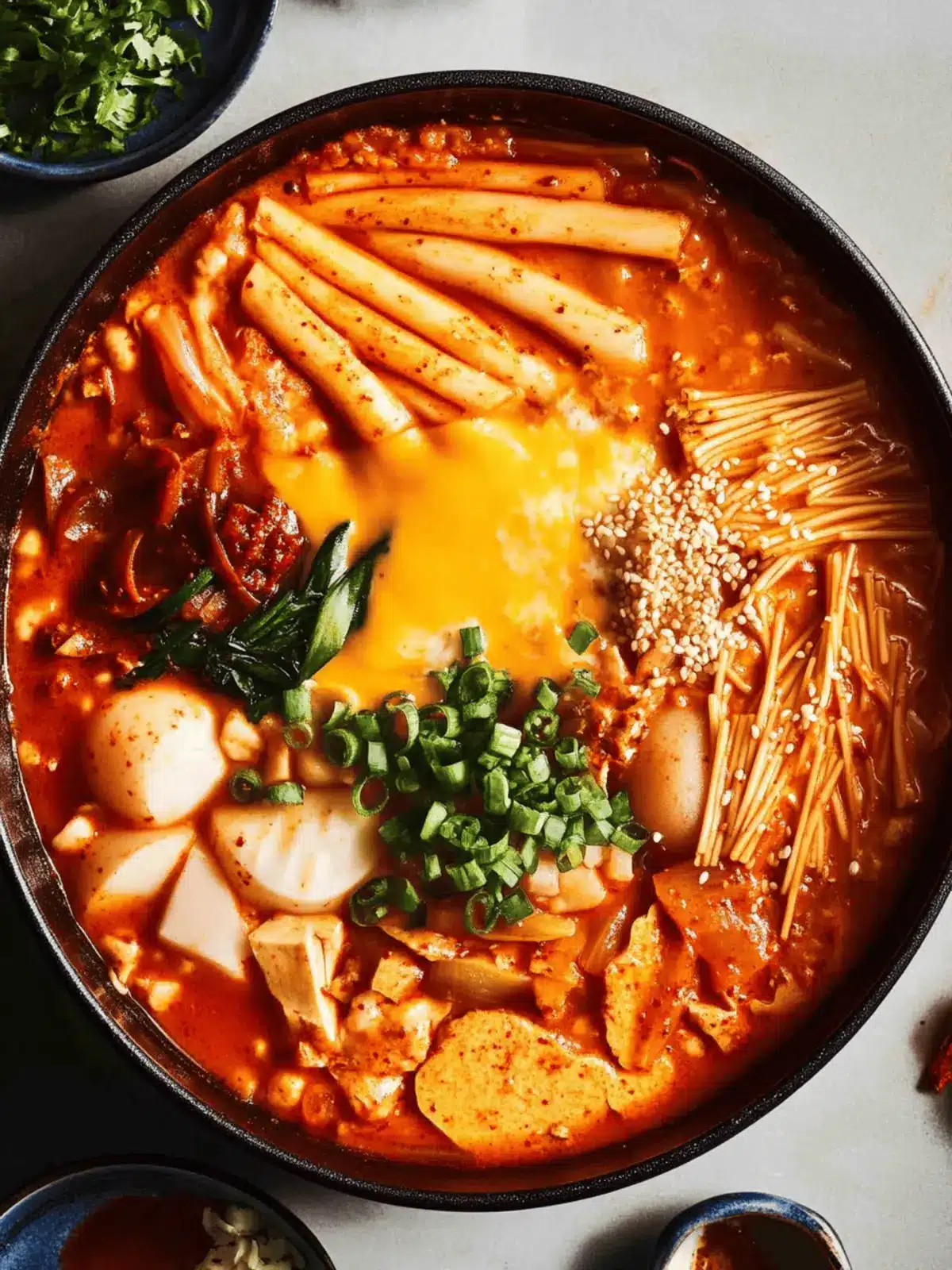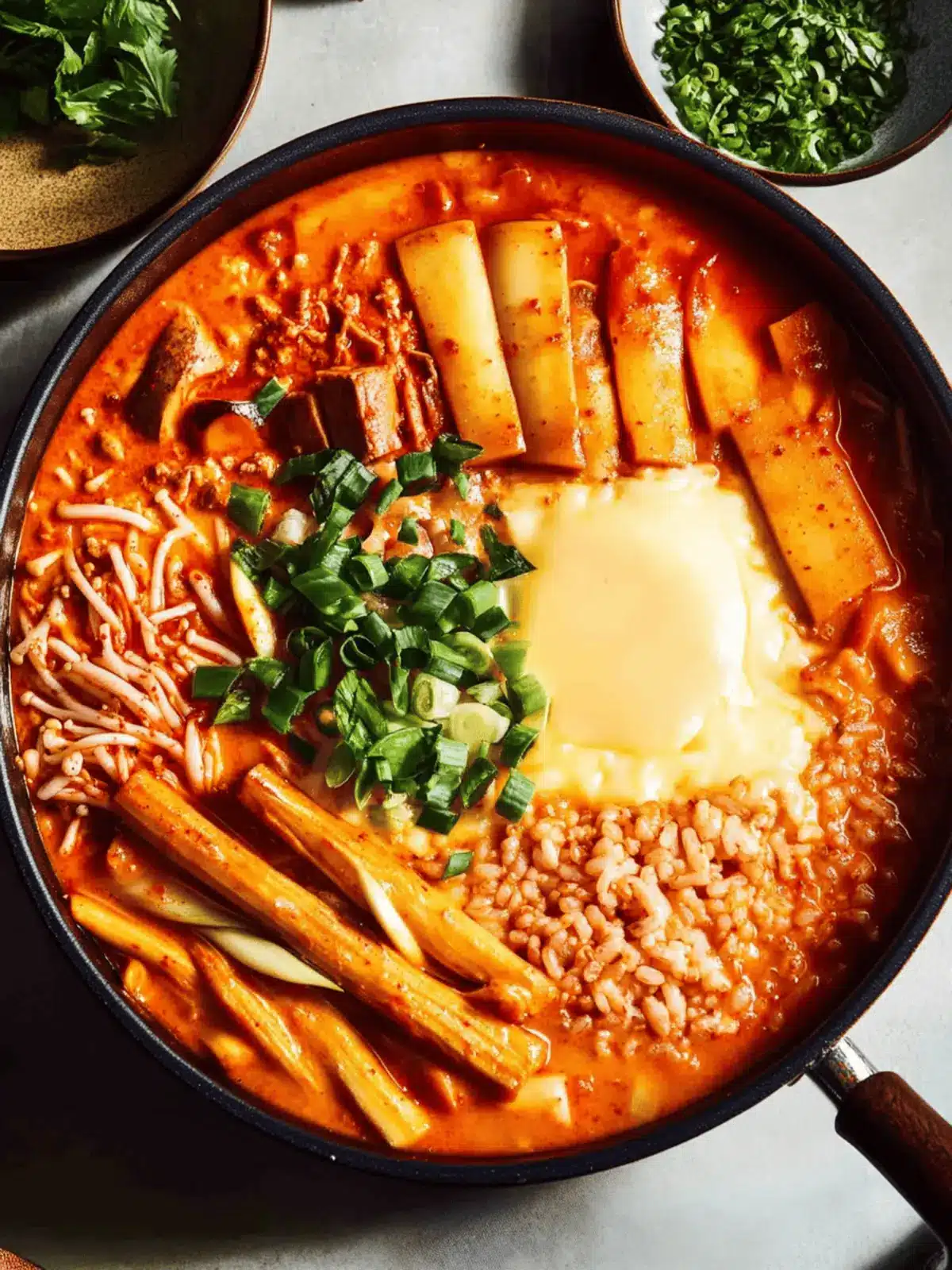When the chill of winter settled in, I found myself craving a bowl of something hearty and comforting. That’s when I rediscovered my love for Budae Jjigae, the Korean Army Stew that warmly embraces all your favorite ingredients into one delicious pot. This vibrant stew, born from necessity after the Korean War, perfectly blends rich flavors with a hint of spice, inviting everyone to gather around the table.
What makes this dish particularly irresistible is its versatility; you can personalize it by throwing in whatever meats and veggies you have on hand. Plus, it’s incredibly budget-friendly, perfect for feeding a crowd without breaking the bank! In just one pot, you can create an unforgettable meal that delivers a luscious, umami-packed experience. So grab your apron, and let’s cook up a steaming bowl of Budae Jjigae that will warm your soul and satisfy your cravings!
Why is Budae Jjigae a Must-Try Recipe?
Comforting Warmth: Budae Jjigae is the ultimate cozy dish perfect for chilly nights, warming your heart with every spoonful.
Rich, Bold Flavors: The blend of gochujang and gochugaru creates a deliciously spicy and umami-packed broth that’s simply irresistible.
Endless Customization: Toss in your favorite meats and vegetables for a unique twist every time, tailoring it to your family’s tastes.
Budget-Friendly: With affordable ingredients, you can feed a crowd without worrying about your wallet.
One-Pot Wonder: Enjoy minimal cleanup as everything cooks together in one pot, letting you focus on savoring the meal!
Embrace this culinary adventure and discover why Budae Jjigae is a dish you’ll want to make again and again!
Budae Jjigae Ingredients
For the Stew Base
- Gochujang – Essential for traditional flavor; this spicy Korean hot pepper paste gives the stew its rich umami kick.
- Water – Forms the base of the stew; substitute with broth for an extra boost of flavor.
- Gochugaru – These Korean hot pepper flakes add heat and sweetness; they’re irreplaceable for that authentic taste.
- Minced Garlic – Adds aromatic depth; fresh garlic is best, but you can use garlic powder in a pinch.
- Soy Sauce – Contributes saltiness and umami; tamari works great for gluten-free diets.
- Sugar – Balances the heat; brown sugar enhances the flavor, but feel free to omit if desired.
For the Heartiness
- Firm Tofu – Gives protein and texture; silken tofu can be a substitute but will change the dish’s consistency.
- Spam – Brings richness to the stew; use turkey Spam or other processed meats for alternatives.
- Mini Sausages – Add heartiness and flavor; swap with any cooked sausage you enjoy.
- Chopped Green Cabbage – Introduces crunch and freshness; any leafy green like bok choy can substitute.
- Tteok (rice cakes) – Provides a delightful chew; can be replaced with quick-cooking noodles if desired.
For the Flavor Boost
- Enoki or Snow White Mushrooms – Enhances flavor and texture; feel free to use any preferred mushrooms in their place.
- Instant Ramen Noodles – Adds carbs and bulk; switch with your favorite noodles if you like.
- American Cheese – Melts beautifully into the broth, adding creaminess; any melty cheese makes a fine substitute.
- Green Onions – For garnish and a burst of flavor; shallots or chives can work in their place.
Prepare these ingredients for a delicious and warming bowl of Budae Jjigae that’s bound to become a family favorite!
How to Make Budae Jjigae
-
Mix the Base: In a small bowl, combine gochujang, water, gochugaru, minced garlic, soy sauce, and sugar to create a spicy, vibrant paste. This will be the flavor foundation for your stew!
-
Layer the Ingredients: In a large pot, start layering your meats and veggies. Arrange the sausages, Spam, tofu, green cabbage, rice cakes, and mushrooms for an inviting presentation.
-
Add the Paste: Spoon the prepared spicy paste mixture over the arranged ingredients, ensuring everything is covered. This step adds that signature kick to your Budae Jjigae!
-
Pour in the Liquid: Gently pour in 5 cups of water, bringing all those wonderful flavors to life. Bring the mixture to a boil, stirring gently to mix the paste thoroughly.
-
Incorporate the Noodles: Once boiling, add the ramen noodles, allowing them to cook until they soften and all ingredients are heated through—about 3-5 minutes.
-
Finish with Cheese: Top the stew with American cheese and sliced green onions. Allow everything to boil for an additional minute before serving to achieve a lovely, creamy texture.
Optional: Serve with steamed rice and kimchi for an extra flavor punch!
Exact quantities are listed in the recipe card below.
Expert Tips for Budae Jjigae
-
Use Fresh Ingredients: Fresh garlic and vegetables elevate the taste; dried or stale items can dull the flavor of your Budae Jjigae.
-
Watch the Heat: Adjust the spice levels by modifying gochujang and gochugaru amounts. Start with less and add more if you like it spicier!
-
Avoid Sogginess: Serve immediately after cooking to prevent noodles and rice cakes from becoming mushy. They’re best enjoyed fresh and hot!
-
Experiment Freely: Feel free to mix up proteins and veggies based on what’s in your fridge. Every version of Budae Jjigae can be a new favorite!
-
Garnish for Flavor: Don’t skip the green onions or cheese topping! They add a delicious contrast that enhances the stew’s richness.
-
Perfecting the Broth: Use broth instead of water for a richer stew base. It adds an extra layer of flavor that complements the other ingredients beautifully.
Storage Tips for Budae Jjigae
Fridge: Store leftover Budae Jjigae in an airtight container for up to 3 days. Make sure it’s cooled down before refrigerating to maintain quality.
Freezer: For longer storage, freeze the stew in portioned containers for up to 2 months. Leave out the noodles, as they can become mushy when reheated.
Reheating: Thaw frozen stew in the fridge overnight, then reheat on the stove over low heat, adding a splash of water to restore the desired consistency.
Serving Suggestions: Always reheat Budae Jjigae before serving and enjoy it fresh for the best flavor experience, ideally with some steamed rice on the side!
Budae Jjigae Variations & Substitutions
Feel free to get creative and tailor this dish to suit your taste buds!
-
Dairy-Free: Swap out American cheese with vegan cheese or nutritional yeast to keep it creamy without dairy.
-
Spicy Kick: Add sliced jalapeños or gochugaru to amp up the heat for those who love an extra kick in their stews.
-
Vegetarian: Replace all meats with hearty mushrooms, extra tofu, or tempeh for a satisfying vegetarian alternative.
-
Noodle Twist: Use udon noodles or rice vermicelli instead of ramen for a different texture and flavor dimension that adds variety.
-
Seasonal Veggies: Incorporate seasonal vegetables like zucchini or bell peppers, giving your stew a fresh twist based on what’s available at the market.
-
Protein Boost: For an extra dose of protein, add beans such as chickpeas or black beans, which complement the stew beautifully with their nutty flavor.
-
Umami Addition: Add a dash of fish sauce or mushrooms to enhance the umami flavor, making the stew even richer without overpowering it.
-
Broth Swap: For a more flavorful base, use beef or chicken broth instead of water; this adds depth to the overall taste of the stew.
Let your culinary imagination run wild with these variations, and enjoy a unique rendition of this comforting classic each time you make it!
What to Serve with Budae Jjigae?
Creating the perfect meal is a delightful journey, and pairing your Budae Jjigae will turn a cozy bowl into a feast!
-
Steamed Rice: Fluffy rice soaks up the spicy broth, balancing the bold flavors of the stew. It’s a classic accompaniment that completes the meal.
-
Kimchi: This fermented side dish adds a crunchy, tangy contrast that enhances the umami of the stew. Plus, it provides a probiotic boost for your gut!
-
Korean Fried Dumplings (Gun Mandu): Crispy on the outside and savory within, these dumplings perfectly complement the creamy richness of your Budae Jjigae. They add an extra layer of enjoyment to your dining experience.
-
Spicy Pickled Radish (Mu): The tangy crunch of pickled radish cuts through the stew’s richness, offering a refreshing bite. It’s a palate cleanser that brightens every mouthful.
-
Cold Noodle Salad (Naengmyeon): This chilled dish provides texture and mild flavors that balance the heat of the stew. Its coolness is a lovely contrast for a comforting meal.
-
Soju or Korean Beer: For drinks, serve with chilled soju or a light Korean beer to complement the spicy notes of Budae Jjigae. They enhance the overall flavor experience while sparking conversations around the table.
These pairings transform your Budae Jjigae into an inviting and memorable meal, leaving everyone craving more!
Make Ahead Options
Budae Jjigae is perfect for meal prep, making it a fantastic choice for busy weeknights! You can prepare the stew base—combine gochujang, water, gochugaru, minced garlic, soy sauce, and sugar—up to 24 hours in advance. Store this mixture in an airtight container in the fridge. Additionally, you can chop your vegetables and layer the meats in the pot up to 3 days ahead, refrigerating them separately to maintain freshness. When you are ready to serve, simply add the prepped ingredients to the pot with water, bring to a boil, and finish by adding the ramen noodles and cheese for a delicious, comforting meal that will taste just as good as if made fresh!
Budae Jjigae (Korean Army Stew) Recipe FAQs
What type of gochujang should I use for Budae Jjigae?
Absolutely! Look for a high-quality gochujang that’s rich and thick; it’s essential for that authentic taste. The heat levels can vary between brands, so if you’re sensitive to spice, start with a milder option or adjust the quantity to your taste.
How can I store leftover Budae Jjigae?
Store your leftovers in an airtight container in the refrigerator for up to 3 days. Make sure the stew has cooled to room temperature before sealing it to maintain its quality. Just reheat it gently on the stove before serving!
Can I freeze Budae Jjigae?
Certainly! Freeze the stew in portioned airtight containers for up to 2 months. It’s best to leave out the noodles before freezing, as they may turn mushy when reheated. To reheat, thaw overnight in the fridge, then warm it up on low heat, adding a splash of water to restore the consistency.
What can I substitute for Spam in Budae Jjigae?
If you’re not a fan of Spam or prefer a healthier option, turkey Spam or any type of cooked sausage works wonderfully! You can also use leftover cooked meats or even extra tofu for a satisfying vegetarian version. Just cut them into bite-sized pieces for even cooking and better texture.
How do I avoid mushy noodles in my stew?
To prevent mushy noodles, serve Budae Jjigae immediately after cooking. If you know you’ll have leftovers, consider cooking the noodles separately and adding them when you’re ready to eat. This way, they’ll stay perfectly chewy and delightful in every bite!
Is Budae Jjigae suitable for everyone, including those with allergies?
Great question! Budae Jjigae can be modified to fit different dietary needs. For gluten-free diners, use tamari instead of soy sauce. Always check labels for specific allergens, especially in processed meats. With careful substitutions, you can enjoy a delicious meal that’s safe for everyone around the table!

Soul-Warming Budae Jjigae (Korean Army Stew) for Cozy Nights
Ingredients
Equipment
Method
- In a small bowl, combine gochujang, water, gochugaru, minced garlic, soy sauce, and sugar to create a spicy, vibrant paste.
- In a large pot, start layering your meats and veggies. Arrange the sausages, Spam, tofu, green cabbage, rice cakes, and mushrooms.
- Spoon the prepared spicy paste mixture over the arranged ingredients, ensuring everything is covered.
- Gently pour in 5 cups of water, bringing all those wonderful flavors to life. Bring the mixture to a boil, stirring gently.
- Once boiling, add the ramen noodles, allowing them to cook until they soften and all ingredients are heated through—about 3-5 minutes.
- Top the stew with American cheese and sliced green onions. Allow everything to boil for an additional minute before serving.








